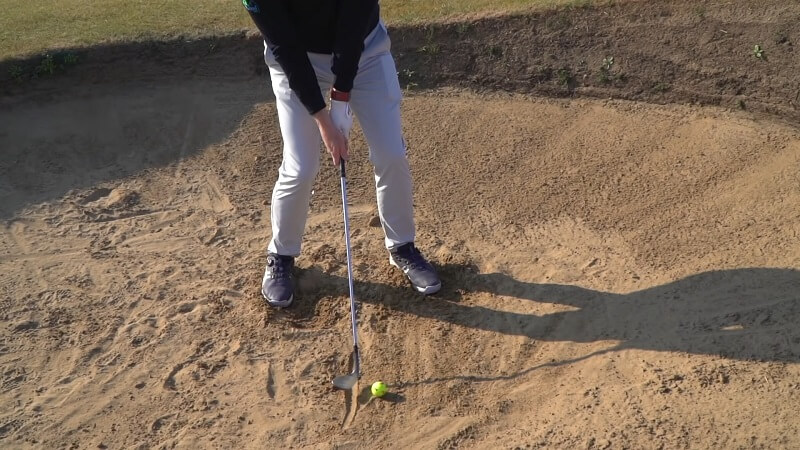Bunkers, or sand traps, are integral to a golf course. They can intimidate players and add a unique challenge to the game. From deep bunkers with steep walls to shallow ones that require delicate touch shots, there is no shortage of ways for bunkers to test your skills on the golf course. Knowing how to play out of them effectively can give you an edge over your opponents.
This article will discuss what is a bunker in golf and introduce different types of bunkers. We’ll also cover Rules regarding hitting from a bunker so you know exactly what’s expected when faced with this hazard on the links.
What Is A Bunker In Golf?
A bunker in golf is a strategically placed sand-filled obstacle on the course designed to challenge and test the skill level of players.
Typically found near the greens or alongside the fairways, these hazards compel golfers to execute accurate shots, demonstrate finesse in their technique, and exhibit astute decision-making.
Both aesthetically appealing and deceptively difficult, bunkers often significantly impact a player’s score, as they require a keen understanding of the game’s tactics and a mastery over their golf clubs.
An essential aspect of course management, these sand traps highlight the unique character of each golf course and represent a defining element that separates triumphant players from the rest.
Why Can Bunkers Be Difficult to Navigate?
Bunkers can be a daunting obstacle for golfers. The sand typically found in bunkers makes it tricky to get the ball out and onto the green. Professional course design can add an extra challenge by strategically placing these difficult features around the golf course.
This forces players to stop and think before they take their next shot; without proper preparation, getting out of a bunker can be nearly impossible. Although navigating bunkers adds more complexity to play, with the right strategies, even rookies may overcome this tricky challenge in no time.
Types of Bunkers In Golf

Players may come across various bunkers that differ in shape, size and depth throughout their round.
Cross Bunkers
The most common type of bunker is the cross bunker, which is typically long and narrow and has walls on either side. Its length and narrow shape create an interesting challenge for players because these bunkers require them to aim precisely to get the ball out successfully.
It can be a daunting obstacle for those attempting a long drive, as a narrower angle towards the hole increases difficulty when playing your shot.
The walls on either side of the cross bunker add further complexity since they can cause unexpected ricochets and changes in direction. In any case, mastering this obstacle can aid you in your golfing game, regardless of your level.
Greenside Bunkers
Greenside bunkers are found near the green and often have steep walls and deep sand, making them difficult to navigate.
Greenside bunkers are some of the most intimidating obstacles golfers will face. With towering walls and deep beds of sand, it’s no surprise that bunkers can frustrate even experienced and skilled golfers.
When confronted with these bunkers near the green, the key is to focus on making an accurate escape shot that can keep your ball close to the pin or in a position from which you can sink a putt.
The angle of your attack combined with the correct club selection – considering powerful winds as well as grain and depth of sand – will be essential to ensure you’re keeping your score down the hole after hole.
Pot Bunkers
Pot bunkers are essential to a golf course and can make all the difference in a demanding game. Not only are they small and round, but their unique concave shape makes it difficult to get a ball out once it has gone in. This makes pot bunkers a great challenge for experienced golfers and rookies trying to improve their game.
Not just providing difficulty, pot bunkers can also be beautifully designed features on a course that adds visual interest when playing.
Church Pews Bunkers
Church pews bunkers are special bunkers that almost appear daunting to golfers.
These long bunkers feature several staggered walls, so angling the shot just right is key to getting the ball out safely. Luckily, they’re not quite as challenging as they look; with a well-executed shot, you could easily get yourself out of a church pew bunker.
These bunkers require practice and mastery to hit successfully – the only way to create that skillful consistency is to hit plenty of balls until it becomes second nature.
Waste Bunkers
Unlike conventional bunkers, these do not fall under the standard hazard classification, which significantly impacts how one can approach playing from such a position.
As a result of this unique classification, golfers are granted the liberty to ground their clubs into the sand for practice swings. This privilege is prohibited in the case of typical sand bunkers.
Rules Regarding Hitting In Bunker

While attempting to escape bunkers, specific rules must be adhered to maintain fair play and adhere to the spirit of the game. The foremost rule is that players are prohibited from grounding their club in the sand before making a stroke. This ensures the player does not receive assistance determining the proper technique for escaping the bunker.
Additionally, golfers must only deliberately touch the sand in the bunker with their hands or club if necessary to remove loose impediments or movable obstructions. When making a stroke in a bunker, a player is entitled to lift and clean their ball only if it has been marked and replaced.
By following these rules, golfers can maintain the challenge and excitement of overcoming the bunkers while preserving the sport’s cherished traditions.
Related post:
- How Are Golf Courses Made?
- What Is A Links Golf Course? Definition & Meaning
- What Is A Golf Driving Range? Everything You Need To Know
- What is An Executive Golf Course? An Introduction to the World of Golf
Conclusion
Bunkers are a great way to make a golf course more challenging, and mastering them will guarantee your success on the course. With practice and familiarity with bunker types, you can become an expert in navigating these traps no matter what type of bunkers you face. By following the correct rules and employing some simple strategies, you can avoid penalty strokes and enjoy a great round of golf.
FAQs
What Is The Difference Between A Bunker And A Sand Trap?
The terms bunker and sand trap are often used interchangeably, but technically a bunker is a type of hazard that contains sand, while a sandtrap is any hazard with a sandy or rough surface.
Why Is It Called A Bunker In Golf?
The bunker’s name is derived from its military-style appearance. According to the modern rules of golf, it can be recognized as an area with a hollow excavated in turf or soil specifically prepared for sand.
Why Can’t I Touch The Sand In Golf?
A golfer can only touch the sand with their club at the point of impact during the stroke. This is because a bunker is classified as a hazard, just like yellow and red-staked water hazards. Also, golfers can only test the sand with their hands if they lift movable objects from the bunker. This is to prevent them from getting an unfair advantage.
Can I Ground My Club In The Bunker?
You can ground your club in a bunker. However, you must not touch the sand or move any stones, rocks and other objects when taking your stance. You can also touch the sand at the point of impact during your stroke.
How Many Bunkers Does A Golf Course Have?
The number of bunkers on a golf course varies depending on the size and design. Typically, you can expect to find between 10 to 15 bunkers on a standard 18-hole golf course. However, some courses may include up to 30 bunkers or more.
What Is The Best Way To Get Out Of A Bunker?
The best way to get out of bunkers is by using the correct stance, club, and shot selection. Make sure your stance is wide enough so that power can be generated while still maintaining balance. Select the right club for the situation and aim to hit the ball out of the bunker in one shot. It is also important to consider the slope of the bunker walls and ensure you are hitting the ball by this. With practice and experience, you will become a master at navigating bunkers.


